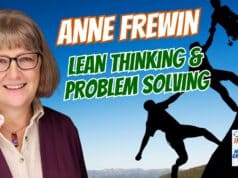Mark's post: I'm still away on vacation, but happy to have some guest bloggers, including Chad Walters. Unlike his past posts, today's not about Lean in sports… and I think you'll enjoy it.
 Obviously one of the most important questions we ask in the field of continuous improvement is “Why?” and for very important reasons – we get answers for reasons decisions were made or we identify potential root causes the more we ask.
Obviously one of the most important questions we ask in the field of continuous improvement is “Why?” and for very important reasons – we get answers for reasons decisions were made or we identify potential root causes the more we ask.
But from the perspective of respect for people, I also offer up “What do you think?” as another important question we should have in our arsenal of inquiries.
When I was a CI engineer with The Dannon Company, I had the great fortune of working with an outside autonomous management consultant named Mark Fougerousse – “Fouge”. I consider him to be one of my mentors because his approach to working with process operators and leaders alike – consideration of all ideas, full inclusion up and down the chain of command, knowledge and investigation instead of accusations and firefighting – is what I try to emulate in my current line of work.
He facilitated trust and ownership with process operators because he challenged them to come up with the answers they felt were right instead of the ones leaders expected. How did he go about doing this? When an operator in one of his projects would bring an idea or question to him with the expectation that he'd provide the answer and direction, Fouge would in turn ask them “Well, what do you think?” He asked in such a way that didn't imply the answer was obvious or in a sarcastic manner – he genuinely put the decision-making power in the hands of the user.
By proactively challenging the operators with “What do you think?” he brought the operators in closer ownership with the processes they run and the leaders responsible for business results.
He never had to tell me “Chad, this is one of the best questions you can ask your project participants” because I could already see the effect it had on bringing leaders and operators together as partners in continuous improvement. In fact, when I approached him with questions, he would often respond in kind with one of his own. I, like the operators, was seeking validation. Instead, what I got from Fouge was autonomy, trust, and control of my own decisions.
It's still one of the best teachings I've ever received and I hope others will take this same approach.
Chad Walters is a Lean consultant and owner of Lean Blitz Consulting in Augusta, Georgia, a firm focused on continuous improvement for small businesses and sports organizations. He has run projects for the Atlanta Braves, the Salvation Army, Automatic Data Processing (ADP), Eaton Corporation, The Dannon Company, and the South Bend Silver Hawks among other companies. He has been practicing Lean and continuous improvement for over eight years, is a Six Sigma Black Belt certified by the American Society for Quality, and received his MBA from Indiana University's Kelley School of Business, where he was a member of the Kelley MBA Sports & Entertainment Academy. Check out his blog…
Please scroll down (or click) to post a comment. Connect with me on LinkedIn.
Let’s build a culture of continuous improvement and psychological safety—together. If you're a leader aiming for lasting change (not just more projects), I help organizations:
- Engage people at all levels in sustainable improvement
- Shift from fear of mistakes to learning from them
- Apply Lean thinking in practical, people-centered ways
Interested in coaching or a keynote talk? Let’s talk.
Join me for a Lean Healthcare Accelerator Trip to Japan! Learn More










[…] The Power of Asking “What Do You Think?” […]
Liked the post. By asking “what do you think?” – you are putting the onus of taking a decision back to the person who asked the question. Great way to bring people around – without forcing a decision on them.
Hi Chad
I like it a lot it is like many truly powerful things so simple yet so important. I have always worked to get other peoples input before giving them an answer as sometimes they come up with something better, but simply and meaningfully asking What do you think, would make the process far better.
Thanks
[…] Kanri for Matt Wrye’s Beyond Lean blog – Jon Spoelstra and Hoshin Kanri for Beyond Lean – The Power of Asking “What Do You Think?” for Mark Graban at Lean […]
Comments are closed.